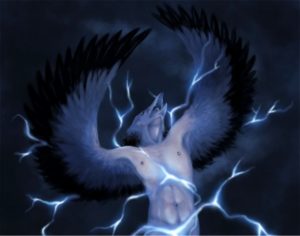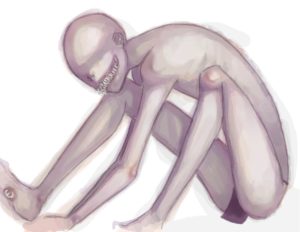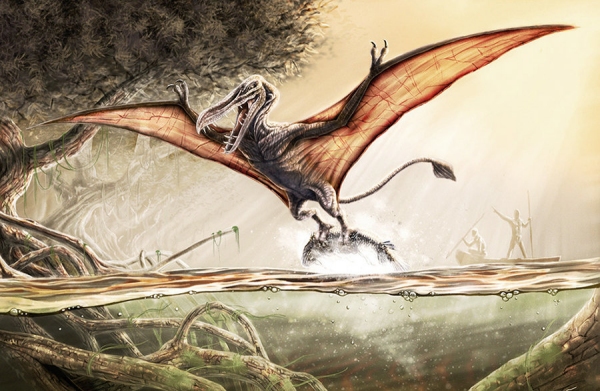This is the second article in our Creatures in the Shadows series. You can read the first one on West African creatures here.
South and South-East Africa is a land of mighty warriors. The Zulu, the Maasai, the Kikuyu, the Ngoni…the names that put fear in the heart of anyone who hears them. The sagas of their terrible wars, of the Great Scattering, or the Desolation of the Kuavi make for a haunting read, and a compelling setting for an exciting novel of epic, Game-of-Thrones proportions. What, then, does a fierce warrior fear? What creatures populate his imagination? What monsters can you encounter in an Eastern African setting?
The Wraiths of Satan
 The Swahili-speaking people of Kenya, Tanzania and Mozambique have a word for malevolent spirits: the Shetani – a borrow from the Arabic “Shaitan”, the Devil. The Shetani resemble crooked, distorted humanoids, with one arm or one eye, haunting and possessing humans and animals alike. They come in various forms, their ways always depraved and terrifying: the Ukunduka, feeding off sexual energies, or the infamous, bat-like Popobawa, violating its victims in their bed.
The Swahili-speaking people of Kenya, Tanzania and Mozambique have a word for malevolent spirits: the Shetani – a borrow from the Arabic “Shaitan”, the Devil. The Shetani resemble crooked, distorted humanoids, with one arm or one eye, haunting and possessing humans and animals alike. They come in various forms, their ways always depraved and terrifying: the Ukunduka, feeding off sexual energies, or the infamous, bat-like Popobawa, violating its victims in their bed.
The jungles of Madagascar are inhabited by the equally evil spirits, the angry ghosts of the forgotten dead, the Angatra, haunting in the vicinity of the graves. A long-neglected and un-placated Angatra turns into the dreaded Kinoly wraith, who will roam the rice fields and village roads, with its fiery red eyes, and razor-sharp dagger-like claws with which it disembowels men alive.
The people of Uganda were also familiar with the less terrifying spirits and ghosts: the Mizimu, haunting their family village, or the grand Balubaale, the guardian saints, great men who protected their tribe even after death. In the forests of Uganda lived the ancient dryads, Kakua Kambuzi, tall, slender and smelling of incense.
The Heart Takers
 But a more corporeal evil lurked in the fields and forests as well; the ever-present vampire race had settled in the South, and took on the novel form of the Lightning Bird, Impundulu. This man-sized black-and-white bird is able to summon thunder and lightning, and is often found in employ of the powerful wizards. In human form it is a beautiful, seductive man, with insatiable appetite for fresh blood, preferably of virgins.
But a more corporeal evil lurked in the fields and forests as well; the ever-present vampire race had settled in the South, and took on the novel form of the Lightning Bird, Impundulu. This man-sized black-and-white bird is able to summon thunder and lightning, and is often found in employ of the powerful wizards. In human form it is a beautiful, seductive man, with insatiable appetite for fresh blood, preferably of virgins.
If Impundulu doesn’t get your blood, the Tikoloshe will; these shape-shifting vampires, also often serving the witches and wizards, can appear as a small teddy-bear-shaped dwarf, or a bear-sized humanoid, always hairy and stocky; they can also show as human males. The Mantindane’s natural form is a ochre-colored dwarf, with beard and moustache, but it can sometimes grow to monster-size, capture and torment humans for its pleasure; its name means, simply, “The Tormentor”.
Madagascar isn’t safe from the blood drinkers, either. The more common variety is known as Mpakafo or Mpakara – literally, the Heart Taker and the Blood Drinker, tall, pale-skinned, long-legged. The Vazimba are smaller than humans, also pale, with elongated faces and large lips, behind which hide long fangs. But the chief of the Madagascar vampires is the princely Ramanga, whose task it was to slurp the blood spilled (by accident or war injury) by the members of the royal family. Originally human servants of the kings, their custom eventually transforms them into powerful wizards.
Almost Human
 Not in the same league of creatures as ghost or vampires, the dwarves and fairy folk of South Africa have some of the most imaginary forms of all the legendary humanoids. There’s the Aigamucha, a race of man-eating creatures who seem almost human, except they have eyes on the soles of their feet. When hunting, they run blind; when spotting prey, they have to stand on their hands. Another man-eating race of humanoid creatures, the Hai-uri, have only one leg and one arm, and travel by jumping. The Kalonoro of Madagascar are ape-like, hairy, telepathic dwarves, less than three feet tall; their feet point backwards, so they are impossible to track.
Not in the same league of creatures as ghost or vampires, the dwarves and fairy folk of South Africa have some of the most imaginary forms of all the legendary humanoids. There’s the Aigamucha, a race of man-eating creatures who seem almost human, except they have eyes on the soles of their feet. When hunting, they run blind; when spotting prey, they have to stand on their hands. Another man-eating race of humanoid creatures, the Hai-uri, have only one leg and one arm, and travel by jumping. The Kalonoro of Madagascar are ape-like, hairy, telepathic dwarves, less than three feet tall; their feet point backwards, so they are impossible to track.
The tiny Abatwa – originally the name of a tribe living in the Central Africa – deserve a book of their own; they are an ant-riding fair folk, living among the blades of grass, largely benevolent, unless you step on one – it will then curse you with its dying breath.
The Hero’s Hunt
The plains and forests of the region are not lacking in the giant beasts; the monsters are the woe of the commoners, but a quarry of heroes. In the rivers, a warrior seeking glory could hunt the Mamlambo, a giant, 60-feet long creature with the body of a fish, short legs, and neck of a snake, glowing green in the night; or the Inkanyamba, a serpent with the head of a horse, living in the shadows of the great waterfalls of South Africa. Hunting the Ilomba might be more tricky – this great sea snake of Zambia can bind its life force with that of its owner, and can only be destroyed by the witch doctor. Lastly, in the waters of Tanganyika lives a giant perch Pamba, so big it can swallow an entire canoe of fishermen.
 Facing the Kongamato could prove a real challenge: the great flying monster of Angola and Zambia, similar to a red pterodactyl, is known as “the breaker of boats”, and its leathery wings span up to 7 feet. In the deserts of Namibia lives its opposite: the Ga-gorib, a pit-dwelling, underground beast, reaching towards passers-by with its leopard-spotted limbs. On the plains of Zimbabwe lives the Ogo, an 8-feet high humanoid creature, whose body is covered with thick, dark-brown fur, an African Yeti; while on the savannah, you could, if you’re very lucky, spot the elusive Ndzoondzoo, the zebra-unicorn. Just be careful not to kill the Nyarvirazi: this were-lioness is actually the cursed daughter of an unfortunate local chieftain, and she will turn human as soon as she eats fresh meat.
Facing the Kongamato could prove a real challenge: the great flying monster of Angola and Zambia, similar to a red pterodactyl, is known as “the breaker of boats”, and its leathery wings span up to 7 feet. In the deserts of Namibia lives its opposite: the Ga-gorib, a pit-dwelling, underground beast, reaching towards passers-by with its leopard-spotted limbs. On the plains of Zimbabwe lives the Ogo, an 8-feet high humanoid creature, whose body is covered with thick, dark-brown fur, an African Yeti; while on the savannah, you could, if you’re very lucky, spot the elusive Ndzoondzoo, the zebra-unicorn. Just be careful not to kill the Nyarvirazi: this were-lioness is actually the cursed daughter of an unfortunate local chieftain, and she will turn human as soon as she eats fresh meat.
After slaying all these monsters, our hero could do well to travel back to Madagascar, to meet the Tompandrano: the huge crocodile with its head glowing in the dark. With a shield made of its great scales, he would be ready to stand against the final prey: the Grootslang.
The Grootslang is a dragon of South Africa; a 50-foot-long ancient serpent, green and metallic, known to devour elephants whole. It gathers diamonds, for which this region is famous, into its cave, and guards it jealously. He who slays the Grootslang and gains its hoard, will be the true hero!
In the next episode, we will jump from East Africa across the Indian Ocean, onto the islands and peninsulas of Malaya, Indonesia, and Philippines.
Title image by damie-m.


This is such a fascinating series!
As I read it, I can’t help but think of how these creatures would translate into an Age of Mythology-style game!!
Living in Southern Africa, I can not imagine seeing mythological creatures such as the Tokoloshe or the Grootslang in the same light as golbins or vampires. Here (at least where the Tokoloshe and Grootslang is concerned) it is more of a superstition. Some people really believe in the existence of these creatures. An unbelievably big group of South Africans (some whom I know) put bricks under the feet of their beds to lift the bed high enough so that the Tokoloshe can not reach them when they sleep. Witch doctors are often employed to get rid of evil spirits or the Tokoloshe – advertisements for this can be found on almost every second street corner. Interestingly, the most read national newspaper in South Africa (the Daily Sun) often reports on sightings of these creatures.
Reading this article makes me wonder wether people in Europe and other continents are as superstitious about “their” mythological creatures?
Trolls and elves are still a great part of folklore and superstition in some parts of Scandinavia and in particular Iceland.
I heard there’s a small renaissance of old Celtic Fair Folk beliefs in Ireland and Wales, similar to Wicca.
I think the only “beings” comparable in Europe would be various ghosts, apparitions and poltergeists. Loads of people still believe and are scared of those.
I’ve been waiting for a part two! Another fascinating post. As a fantasy reader, it’s good to hear about lesser known creatures. As a fantasy writer, it’s good to be inspired by creatures other than elves, dragons and dwarves. Keep them coming, James!
Please can you write on the mythologies of other parts of Africa, say West Africa?
We’ve actually done West Africa already. 🙂 You can read the article here: http://fantasy-faction.com/2013/the-creatures-in-the-shadows-west-africa
A while ago I posted about how fantasy creatures in South Africa are often times not merely seen as folklore, but as reality. I just found a prime example in one of our national newspapers. A couple of days ago we had a bad hailstorm, and some ascribe it to be the work of an angry mermaid. You can read it here: http://dailysun.mobi/news/read/3417/mermaid-caused-hail
So for fantasy writers struggling with inspiration, maybe reading the sun would help kickstart your next story?
I’m working on a campaign world for RPGs based on Bantu mythology. This page is fantastic! I could add a few (cannibal with extra mouths on the backs of their necks, plus you can’t forget crowing cobras and ikonkola!), but you picked up several I missed. Great stuff. I’d love to know the origin of the word ‘ha-uri’. I’ve been calling the 1/2men ‘Chilube’. I try to use kiSwahili when I can’t but I can’t find the word. Hmm – you might ougta mention ‘wazimwi’ too, the oddly civil Bantu ogres that show up in so many tales.
Hi Mzimwi. I am also South African and an avid RPG player. Do you have more info on your project?
[…] Part One – West Africa Part Two – South and East Africa […]
do you have a book or books with more info on African myths and creatures i love all of this and like to know more so i can do some paintings and make few comic books for my nephews just to pass on the hole hero of legend myth and rhyme i remember from when i was there age